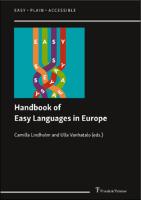Handbook of Easy Languages in Europe
Contributor(s)
Lindholm, Camilla (editor)
Vanhatalo, Ulla (editor)
Language
EnglishAbstract
The Handbook of Easy Languages in Europe describes what Easy Language is and how it is used in European countries. It demonstrates the great diversity of actors, instruments and outcomes related to Easy Language throughout Europe. All people, despite their limitations, have an equal right to information, inclusion, and social participation. This results in requirements for understandable language. The notion of Easy Language refers to modified forms of standard languages that aim to facilitate reading and language comprehension. This handbook describes the historical background, the principles and the practices of Easy Language in 21 European countries. Its topics include terminological definitions, legal status, stakeholders, target groups, guidelines, practical outcomes, education, research, and a reflection on future perspectives related to Easy Language in each country. Written in an academic yet interesting and understandable style, this Handbook of Easy Languages in Europe aims to find a wide audience.
Keywords
Accessible Communication; Europe; barrier-free; Accessibility; Communication; Easy Language; InclusionDOI
10.26530/20.500.12657/52628ISBN
9783732907717, 9783732991945, 9783732991952Publisher
Frank & TimmePublisher website
https://www.frank-timme.de/Publication date and place
Berlin, 2021Classification
Semantics, discourse analysis, stylistics
Grammar, syntax and morphology
Translation and interpretation
Society and Social Sciences
Europe
Educational strategies and policy


 Download
Download Web Shop
Web Shop